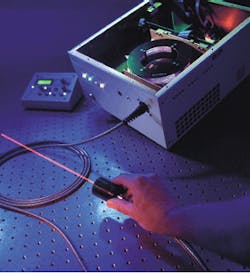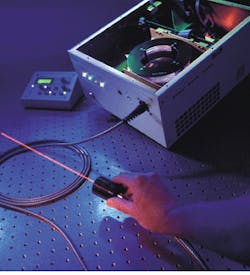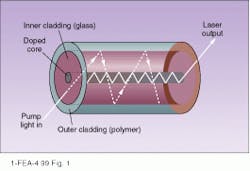Double-clad fibers enable lasers to handle high power
Double-clad fibers enable lasers to handle high power
New optical technology has left the laboratory for industrial applications ranging from graphic arts to telecommunications.
Gordon Mitchard and Rob Waarts
During the past two years, high-power fiber-laser technology has successfully left the research laboratory for deployment in a diverse range of applications. Fueling this market growth are the technology`s characteristic high beam quality, reliability, and efficiency, as well as compact size and ease of use (see photo).
In the graphic arts industry, for example, fiber lasers are used in thermal internal-drum direct-to-plate imaging systems, which demand high power and diffraction-limited beam quality. In the micromachining arena, the technology is carving out a niche in welding, bending, aligning, stress relieving, soldering, and heat-treating applications for the magnetic and optical storage, semiconductor, and electronics industries. Fiber lasers also are being rapidly adopted for marking applications, especially in the semiconductor industry for marking plastic and ceramic packages.
Applications also extend into the communications industry, where R&D labs are relying on high-power (>1 W) fiber amplifiers in research related to the development of high-performance dense-wavelength-division-multiplexing components and systems. Engineers also are using them as high-power modulatable sources for lidar and specialized alignment applications.
Fiber-laser advantages
The key to market penetration is the fiber laser`s ability to compete with more-conventional technology. In materials-processing applications, for example, fiber lasers compete with conventional diode-pumped solid-state (DPSS) laser technology. In DPSS systems, thermal management within the laser cavity is a concern, which leads to compromises between beam quality and system efficiency. Because the fiber creates an optical laser cavity that is tens of meters long with a very large surface area, heat dissipation in a fiber laser cavity is substantially accelerated. This eliminates the beam quality degradation and reduced system efficiency caused by adverse thermal effects. Also, the double-clad fiber geometry ensures that all pump light is absorbed within the laser cavity, which increases optical-to-optical conversion efficiency by almost a factor of two over conventional DPSS systems, to in excess of 60% (see Fig. 2). Because the laser is an integrated, single-mode silica fiber, there is no potential for performance degradation from intracavity contamination or misalignment. The system will maintain diffraction-limited beam quality independent of variables like system age or environmental changes.
Commercial fiber-laser systems for materials processing that operate from 1060 to 1100 nm typically contain ytterbium (Yb) as the rare-earth dopant, although other materials such as neodymium (Nd) have been used. In the communications market, double-clad fibers codoped with erbium (Er) and ytterbium can be components of high-power (greater than 1W) optical amplifiers. In such systems, the ytterbium absorbs the pump light, and the absorbed energy transfers resonantly to neighboring erbium atoms, which provides gain at 1550 nm. Fibers are commonly doped with ytterbium because it has relatively broad absorption bands around 920 and 980 nm, wavelengths at which very-high-reliability, multimode diode lasers are available as pump sources. There also tends to be higher conversion efficiency of the optical pump light into laser output, typically greater than 60%.
Working lasers
In just a short time, hundreds of commercial fiber lasers have been sold worldwide. Equally important, they have accumulated hundreds of thousands of operating hours, a key step to proving their practicality in industrial applications. In January 1997, for example, SDL Inc. and Polaroid Corp. jointly introduced a commercial Yb-doped fiber laser system operating at 1110 nm. Currently, a 15-W system is available that is compact, air-cooled, and driven from standard wall-plug power [this laser is winner of the 1999 Laser Focus World CTA Award for nondiode lasers: see p. 110-Ed.]. In general, commercial fiber lasers can operate at wavelengths from 1060 to 1120 nm and output powers of several watts. They can generate output wavelengths to 1500 nm when integrated with a cascaded Raman resonator.
Such performance can be expected to improve. Research and development around Yb-doped double-clad fiber has focused primarily on obtaining higher average-output power, in addition to high pulse energies and peak powers. In some cases, average output powers have reached 55 W at around 1110 nm and have been limited primarily by the available pump power injected into the double-clad fiber. The output wavelength of fiber laser sources can also extend to shorter wavelengths by frequency conversion in nonlinear crystals. Frequency doubling of a 4.8-W 1080-nm Yb-doped laser has generated 590 mW of output power in the green.1
Development efforts have also produced pulsed operation from fiber lasers via a variety of double-clad fibers and architectures. In different experiments at 1060 nm and 1550 nm, peak powers reached 5 to 10 kW, pulse energies were up to 0.5 mJ, and average output power exceeded 5 W.2,3 A fiber laser can be pulsed through Q-switched operation of the fiber cavity by inserting a switch, typically an acousto-optic modulator, within the cavity. Alternatively, the double-clad fiber can be used to amplify the output from a low-power, pulsed diode laser source. This configuration has an advantage over Q-switching because it permits control over the temporal output format with flexible repetition rate and pulse length. There also is very high pulse-to-pulse stability.
Double-clad fiber amplifiers have also been demonstrated in the laboratory as high-power, high-speed transmitters. For instance, a 2.5-Gbit/s Yb-doped-fiber-amplifier-based transmitter has been demonstrated with more than 5 W of output power at around 1070 nm.
Looking forward
In the future, double-clad fiber technology should find more applications in both telecommunications and materials processing. Fiber lasers that are Yb-doped and operate at output powers up to the kilowatt level will open up additional markets, including cutting and welding. Currently, the finite brightness of pump sources and the numerical aperture of the inner cladding collecting the pump light limit the pump power that can be coupled into the end of the fiber. This effectively limits the output power available from double-clad fiber sources today. In the future, pump sources of higher brightness, as well as different technologies for coupling the pump light into the double-clad fiber, such as side pumping the fiber, offer the potential for much-higher average-output powers.
The ultimate limit in the capacity of double-clad fiber to handle high power has not yet been found. The main concern in scaling to higher output power is the power density in the small single-mode core. Current commercial fiber laser products at the 9- and 15-W output levels show no fiber degradation. This corresponds to a power density in the core of around 20-30 MW/ cm2. Experiments in pure fused quartz have shown damage thresholds at 1-10 GW/cm2, which would correspond to fiber laser output powers of about 10-100 kW. o
REFERENCES
1. J. Webjorn et al., Proc. CLEO 6, 76 (1998).
2. L. Offerhaus et al., Opt. Lett. 23, 1683 (1998).
3. S. MacCormack et al., "High-speed, high-power, double-clad fiber amplifiers," Proc. CLEO 6, 227 (1998).
FIGURE 1. Inherent simplicity of fiber laser system leads to high reliability and ease of use in applications such as graphic arts and materials processing.
FIGURE 2. Gain medium in double-clad optical fiber is a rare-earth-doped, single-spatial-mode silica fiber in which two cladding layers, each with a different refraction index surround the fiber core (top). The index mismatch between inner and outer layers restricts pump light to the inner cladding layer, from which it traverses the fiber core area. In a typical fiber-laser configuration, the double-clad fiber is configured into a resonant laser cavity by introducing a mirror at each end (bottom). The input mirror transmits at the optical pump wavelength (typically 920 nm) and reflects at the laser wavelength (typically 1110 nm). The output mirror transmits at the laser wavelength and reflects at the optical pump wavelength. Output from a highly reliable, multimode InGaAs (indium gallium arsenide) diode laser coupled into the inner cladding layer optically pumps the laser cavity. Collimating or focusing optics then couple the diffraction-limited output from the single-mode fiber laser cavity to the application.
GORDON MITCHARD is director of laser system products and ROB WAARTS is research business manager at SDL Inc., 80 Rose Orchard Way, San Jose, CA 95134-1365; e-mail: [email protected].



